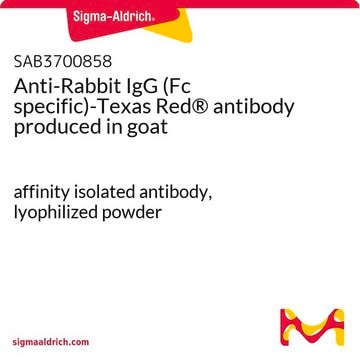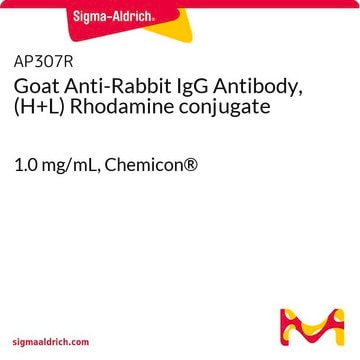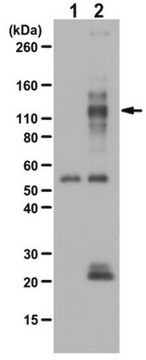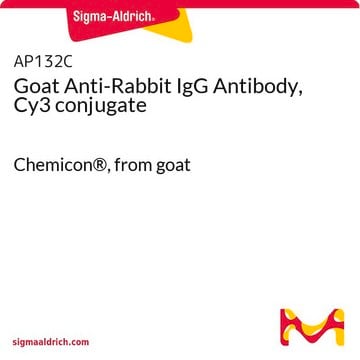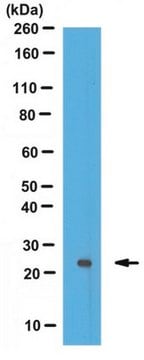AP132R
Goat Anti-Rabbit IgG Antibody, Rhodamine conjugate
Chemicon®, from goat
Sign Into View Organizational & Contract Pricing
All Photos(1)
About This Item
UNSPSC Code:
12352203
eCl@ss:
32160702
NACRES:
NA.46
Recommended Products
biological source
goat
Quality Level
conjugate
TRITC conjugate
rhodamine conjugate
antibody form
affinity purified immunoglobulin
antibody product type
secondary antibodies
clone
polyclonal
species reactivity
rabbit
manufacturer/tradename
Chemicon®
technique(s)
immunofluorescence: suitable
shipped in
wet ice
target post-translational modification
unmodified
Related Categories
Specificity
Rabbit IgG
WAVELENGTH:
Absorption peak = 550 nm, Emission peak = 570 nm.
WAVELENGTH:
Absorption peak = 550 nm, Emission peak = 570 nm.
Application
Goat anti-Rabbit IgG Antibody, Rhodamine conjugate is an antibody against Rabbit IgG for use in IF.
Research Category
Secondary & Control Antibodies
Secondary & Control Antibodies
Research Sub Category
Whole Immunoglobulin Secondary Antibodies
Whole Immunoglobulin Secondary Antibodies
Suggested dilution for most applications: 1:50-1:200 Optimal working dilutions must be determined by end user.
Physical form
Lyophilized. Buffer = 0.02 M Sodium Phosphate, 0.25 M NaCl, pH 7.6 with 15 mg/mL BSA, and 0.1% sodium azide.
RECONSTITUTION:
Reconstitute with 2 mL of sterile distilled water
RHODAMINE/PROTEIN:
Approximately 0.62 (A550/A280).
RECONSTITUTION:
Reconstitute with 2 mL of sterile distilled water
RHODAMINE/PROTEIN:
Approximately 0.62 (A550/A280).
Storage and Stability
Maintain lyophilized product at 2-8°C for up to 12 months. After reconstitution the product is stable for several weeks at 2-8°C as an undiluted liquid. For extended storage after reconstitution, add an equal volume of glycerol to make a final concentration of 50% glycerol followed by storage at -20°C in undiluted aliquots for up to 12 months. Please note the concentration of protein (and buffer salts) will decrease to one-half of the original after the addition of glycerol. Avoid repeated freeze/thaw cycles.
Legal Information
CHEMICON is a registered trademark of Merck KGaA, Darmstadt, Germany
Disclaimer
Unless otherwise stated in our catalog or other company documentation accompanying the product(s), our products are intended for research use only and are not to be used for any other purpose, which includes but is not limited to, unauthorized commercial uses, in vitro diagnostic uses, ex vivo or in vivo therapeutic uses or any type of consumption or application to humans or animals.
Not finding the right product?
Try our Product Selector Tool.
Hazard Statements
Precautionary Statements
Hazard Classifications
Aquatic Chronic 3
Storage Class Code
11 - Combustible Solids
WGK
WGK 3
Certificates of Analysis (COA)
Search for Certificates of Analysis (COA) by entering the products Lot/Batch Number. Lot and Batch Numbers can be found on a product’s label following the words ‘Lot’ or ‘Batch’.
Already Own This Product?
Find documentation for the products that you have recently purchased in the Document Library.
Xinyu Xu et al.
European journal of histochemistry : EJH, 67(1) (2023-02-15)
The purpose of the study was to investigate the effect of artificial light with different spectral composition and distribution on axial growth in guinea pigs. Three-week-old guinea pigs were randomly assigned to groups exposed to natural light, low color temperature light-emitting
I-Neng Lee et al.
Oncology letters, 21(6), 443-443 (2021-04-20)
Drug resistance and disease recurrence are important contributors for the poor prognosis of glioblastoma multiforme (GBM). Temozolomide (TMZ), the standard chemotherapy for GBM treatment, can methylate DNA and cause the formation of double-strand breaks (DSBs). X-ray repair cross complementing 5
Li Wei et al.
International journal of cancer, 125(4), 791-806 (2009-04-25)
Clusterin (CLU) is a multivalent glycoprotein with ubiquitous tissue distribution. To address the possible differential functional roles assumed by different isoforms of CLU in the progression of human ovarian cancer, we constructed 2 human ovarian cancer cell models that represent
Laura Paz-Artigas et al.
ACS biomaterials science & engineering, 10(2), 987-997 (2024-01-18)
A combination of human-induced pluripotent stem cells (hiPSCs) and 3D microtissue culture techniques allows the generation of models that recapitulate the cardiac microenvironment for preclinical research of new treatments. In particular, spheroids represent the simplest approach to culture cells in
Characterization of pancreatic stem cells derived from adult human pancreas ducts by fluorescence activated cell sorting.
Lin, HT; Chiou, SH; Kao, CL; Shyr, YM; Hsu, CJ; Tarng, YW; Ho, LL; Kwok, CF; Ku, HH
World Journal of Gastroenterology null
Our team of scientists has experience in all areas of research including Life Science, Material Science, Chemical Synthesis, Chromatography, Analytical and many others.
Contact Technical Service
